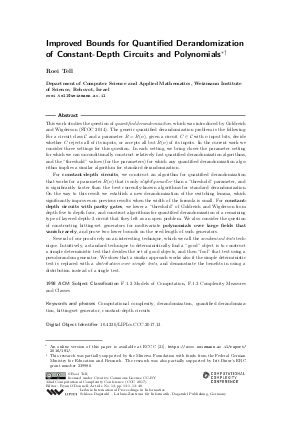Improved Bounds for Quantified Derandomization of Constant-Depth Circuits and Polynomials
Author Roei Tell
-
Part of:
Volume:
32nd Computational Complexity Conference (CCC 2017)
Part of: Series: Leibniz International Proceedings in Informatics (LIPIcs)
Part of: Conference: Computational Complexity Conference (CCC) - License:
 Creative Commons Attribution 3.0 Unported license
Creative Commons Attribution 3.0 Unported license
- Publication Date: 2017-08-01
File

PDF
LIPIcs.CCC.2017.13.pdf
- Filesize: 0.95 MB
- 48 pages
Document Identifiers
Subject Classification
Keywords
- Computational complexity
- derandomization
- quantified derandomization
- hitting-set generator
- constant-depth circuits
Metrics
- Access Statistics
-
Total Accesses (updated on a weekly basis)
0Document
0Metadata
Abstract
This work studies the question of quantified derandomization, which was introduced by Goldreich and Wigderson (STOC 2014). The generic quantified derandomization problem is the following: For a circuit class cal{C} and a parameter B=B(n), given a circuit C in cal{C} with n input bits, decide whether C rejects all of its inputs, or accepts all but B(n) of its inputs. In the current work we consider three settings for this question. In each setting, we bring closer the parameter setting for which we can unconditionally construct relatively fast quantified derandomization algorithms, and the "threshold" values (for the parameters) for which any quantified derandomization algorithm implies a similar algorithm for standard derandomization.
For constant-depth circuits, we construct an algorithm for quantified derandomization that works for a parameter B(n) that is only slightly smaller than a "threshold" parameter, and is significantly faster than the best currently-known algorithms for standard derandomization. On the way to this result we establish a new derandomization of the switching lemma, which significantly improves on previous results when the width of the formula is small. For constant-depth circuits with parity gates, we lower a "threshold" of Goldreich and Wigderson from depth five to depth four, and construct algorithms for quantified derandomization of a remaining type of layered depth-3 circuit that they left as an open problem. We also consider the question of constructing hitting-set generators for multivariate polynomials over large fields that vanish rarely, and prove two lower bounds on the seed length of such generators.
Several of our proofs rely on an interesting technique, which we call the randomized tests technique. Intuitively, a standard technique to deterministically find a "good" object is to construct a simple deterministic test that decides the set of good objects, and then "fool" that test using a pseudorandom generator. We show that a similar approach works also if the simple deterministic test is replaced with a distribution over simple tests, and demonstrate the benefits in using a distribution instead of a single test.
Cite As Get BibTex
Roei Tell. Improved Bounds for Quantified Derandomization of Constant-Depth Circuits and Polynomials. In 32nd Computational Complexity Conference (CCC 2017). Leibniz International Proceedings in Informatics (LIPIcs), Volume 79, pp. 13:1-13:48, Schloss Dagstuhl – Leibniz-Zentrum für Informatik (2017)
https://doi.org/10.4230/LIPIcs.CCC.2017.13
BibTex
@InProceedings{tell:LIPIcs.CCC.2017.13,
author = {Tell, Roei},
title = {{Improved Bounds for Quantified Derandomization of Constant-Depth Circuits and Polynomials}},
booktitle = {32nd Computational Complexity Conference (CCC 2017)},
pages = {13:1--13:48},
series = {Leibniz International Proceedings in Informatics (LIPIcs)},
ISBN = {978-3-95977-040-8},
ISSN = {1868-8969},
year = {2017},
volume = {79},
editor = {O'Donnell, Ryan},
publisher = {Schloss Dagstuhl -- Leibniz-Zentrum f{\"u}r Informatik},
address = {Dagstuhl, Germany},
URL = {https://drops.dagstuhl.de/entities/document/10.4230/LIPIcs.CCC.2017.13},
URN = {urn:nbn:de:0030-drops-75349},
doi = {10.4230/LIPIcs.CCC.2017.13},
annote = {Keywords: Computational complexity, derandomization, quantified derandomization, hitting-set generator, constant-depth circuits}
}
Author Details
References
-
M. Bellare and J. Rompel. Randomness-efficient oblivious sampling. In \focs35th, pages 276-287, 1994.

-
Andrej Bogdanov. Pseudorandom generators for low degree polynomials. In \stoc37th, pages 21-30. 2005.

-
Andrej Bogdanov and Emanuele Viola. Pseudorandom bits for polynomials. \siamj, 39(6):2464-2486, 2010.

-
Shiva Chaudhuri and Jaikumar Radhakrishnan. Deterministic restrictions in circuit complexity. In \stoc28th, pages 30-36, 1996.

-
Kuan Cheng and Xin Li. Randomness extraction in AC0 and with small locality. \eccc, 23:18, 2016.

-
Gil Cohen and Amnon Ta-Shma. Pseudorandom generators for low degree polynomials from algebraic geometry codes. \eccc, 20:155, 2013.

-
Anindya De, Omid Etesami, Luca Trevisan, and Madhur Tulsiani. Improved pseudorandom generators for depth 2 circuits. In \rnd14th, pages 504-517, 2010.

- Oded Goldreich. Introduction to Property Testing (working draft), February 7, 2017. Accessed at http://www.wisdom.weizmann.ac.il/~oded/pt-intro.html, February 14, 2017.
-
Oded Goldreich and Avi Widgerson. On derandomizing algorithms that err extremely rarely. In \stoc46th, pages 109-118. 2014. Full version available online at \eccc, 20:152 (Rev. 2), 2013.

-
Parikshit Gopalan, Raghu Meka, and Omer Reingold. Dnf sparsification and a faster deterministic counting algorithm. ç, 22(2):275-310, 2013.

-
Johan Håstad. Computational Limitations of Small-depth Circuits. MIT Press, 1987.

-
Russell Impagliazzo and Avi Wigderson. P = BPP if E requires exponential circuits: derandomizing the XOR lemma. In \stoc29th, pages 220-229. 1999.

-
Swastik Kopparty and Srikanth Srinivasan. Certifying polynomials for AC^0[⊕] circuits, with applications. In \fsttcs32nd, pages 36-47. 2012.

-
Shachar Lovett, Omer Reingold, Luca Trevisan, and Salil Vadhan. Pseudorandom bit generators that fool modular sums. In \rnd13th, pages 615-630. 2009.

-
Noam Nisan and Avi Wigderson. Hardness vs. randomness. \jcss, 49(2):149-167, 1994.

-
Ryan O'Donnell. Analysis of Boolean Functions. Cambridge University Press, 2014.

-
Alexander A. Razborov. Lower bounds on the size of constant-depth networks over a complete basis with logical addition. Mathematical Notes of the Academy of Science of the USSR, 41(4):333-338, 1987.

-
Benjamin Rossman. The monotone complexity of k-clique on random graphs. \siamj, 43(1):256-279, 2014.

-
Wolfgang M. Schmidt. Equations over Finite Fields: An Elementary Approach. Springer-Verlag Berlin, 1976.

-
Avishay Tal. Tight bounds on the fourier spectrum of AC⁰. \eccc, 21:174, 2014.

- Roei Tell. Improved bounds for quantified derandomization of constant-depth circuits and polynomials. \eccc, 23, 2016. TR16-191. URL: https://eccc.weizmann.ac.il/report/2016/191/.
-
Luca Trevisan. Extractors and pseudorandom generators. \jacm, 48(4):860-879, 2001.

-
Luca Trevisan and TongKe Xue. A derandomized switching lemma and an improved derandomization of AC0. In çc28th, pages 242-247. 2013.

-
Salil P. Vadhan. Pseudorandomness. Foundations and Trends in Theoretical Computer Science. Now Publishers, 2012.

-
Emanuele Viola. The sum of d small-bias generators fools polynomials of degree d. ç, 18(2):209-217, 2009.

